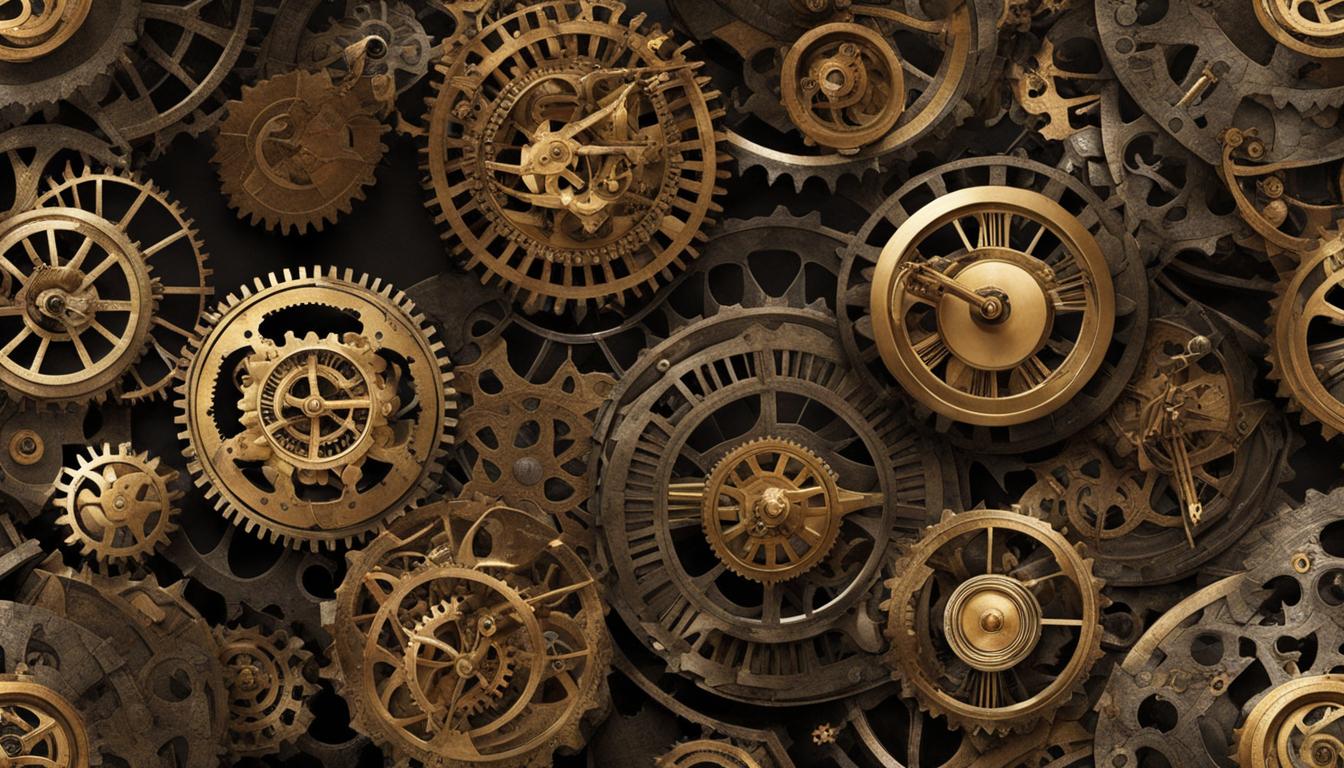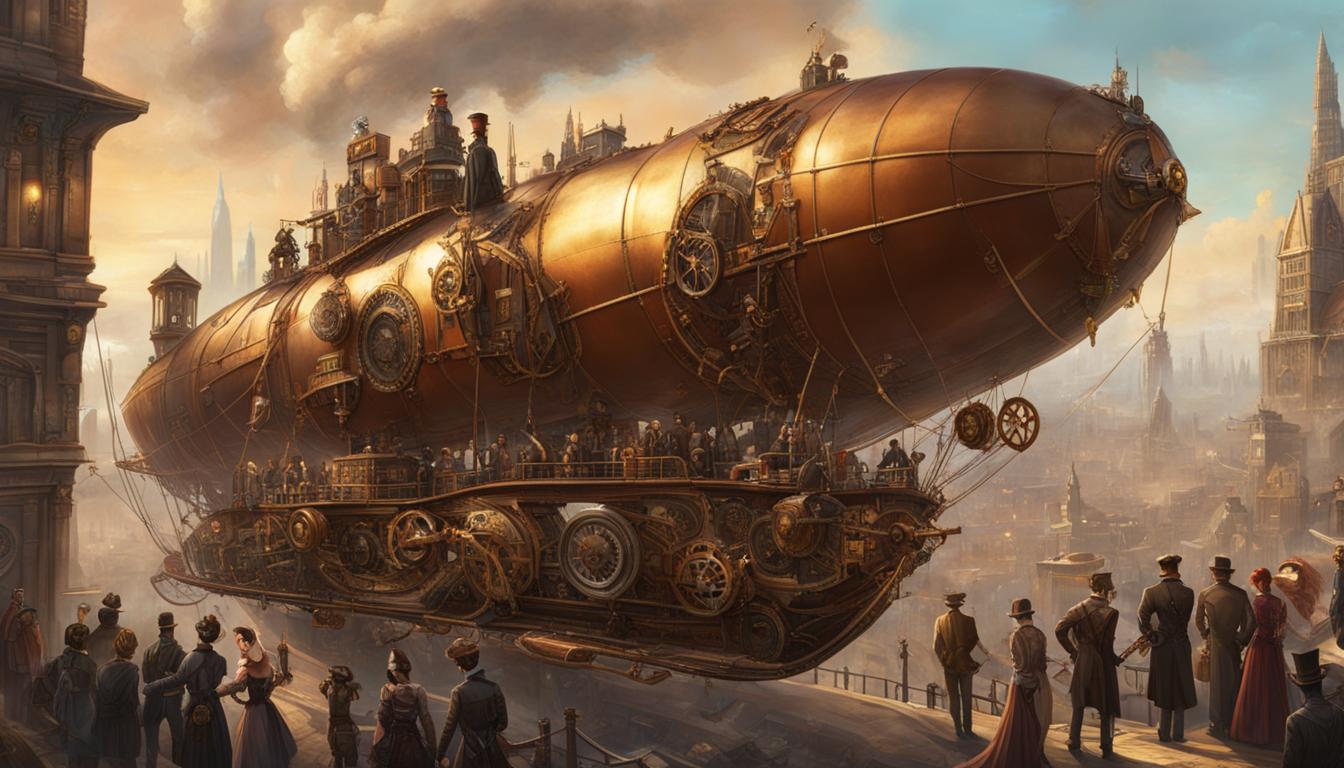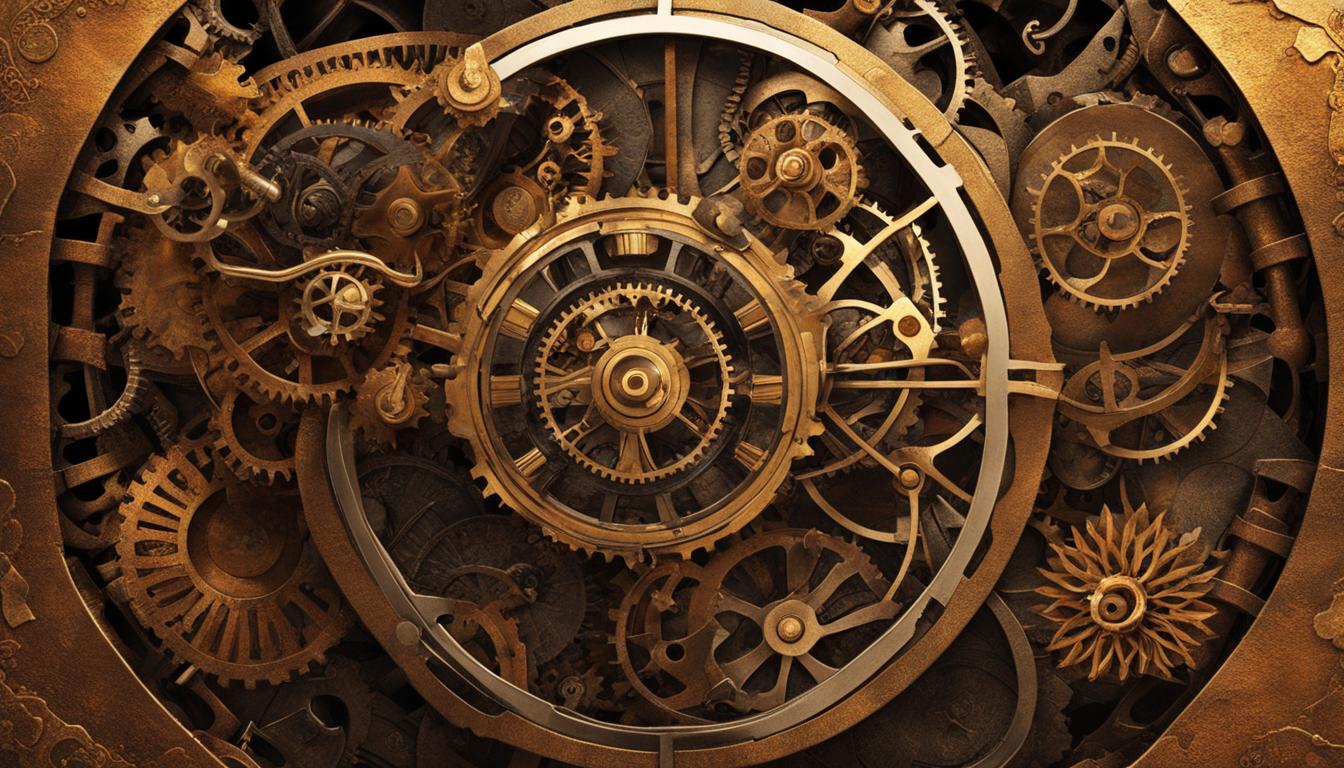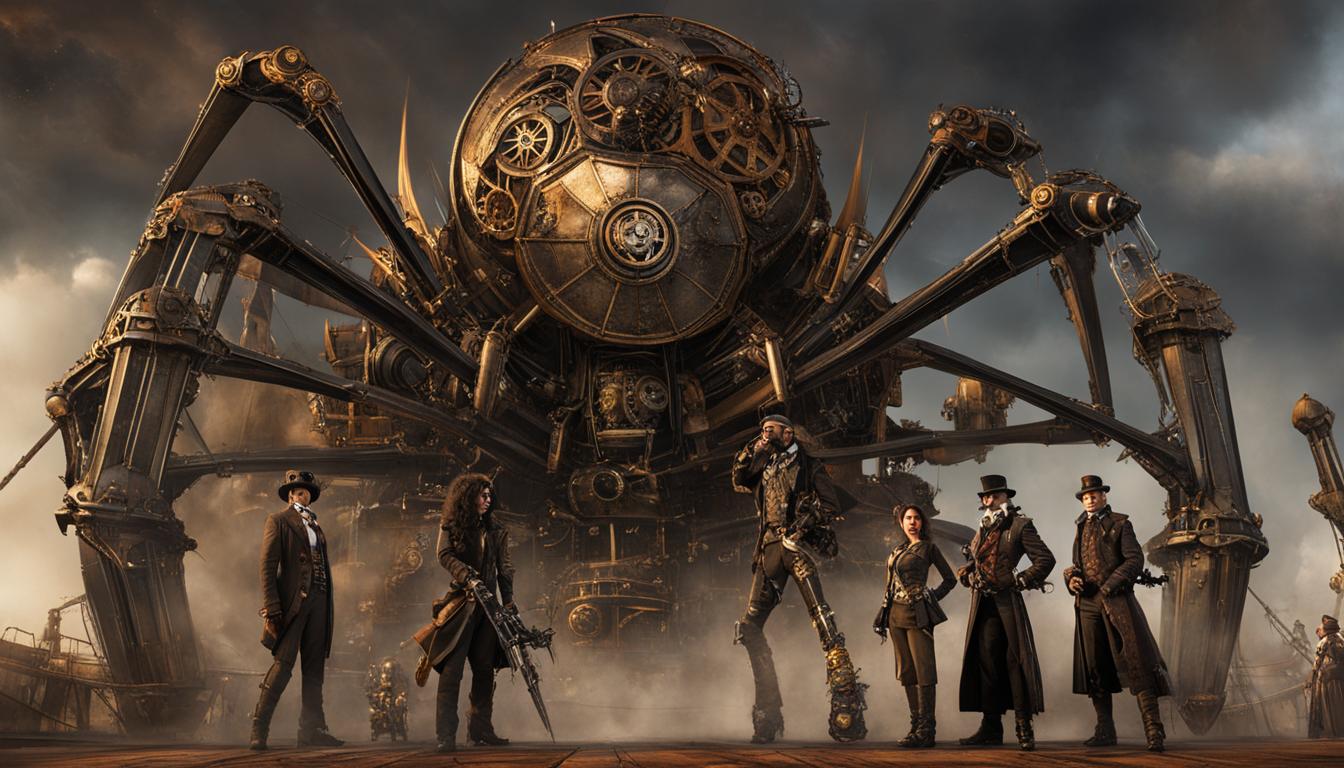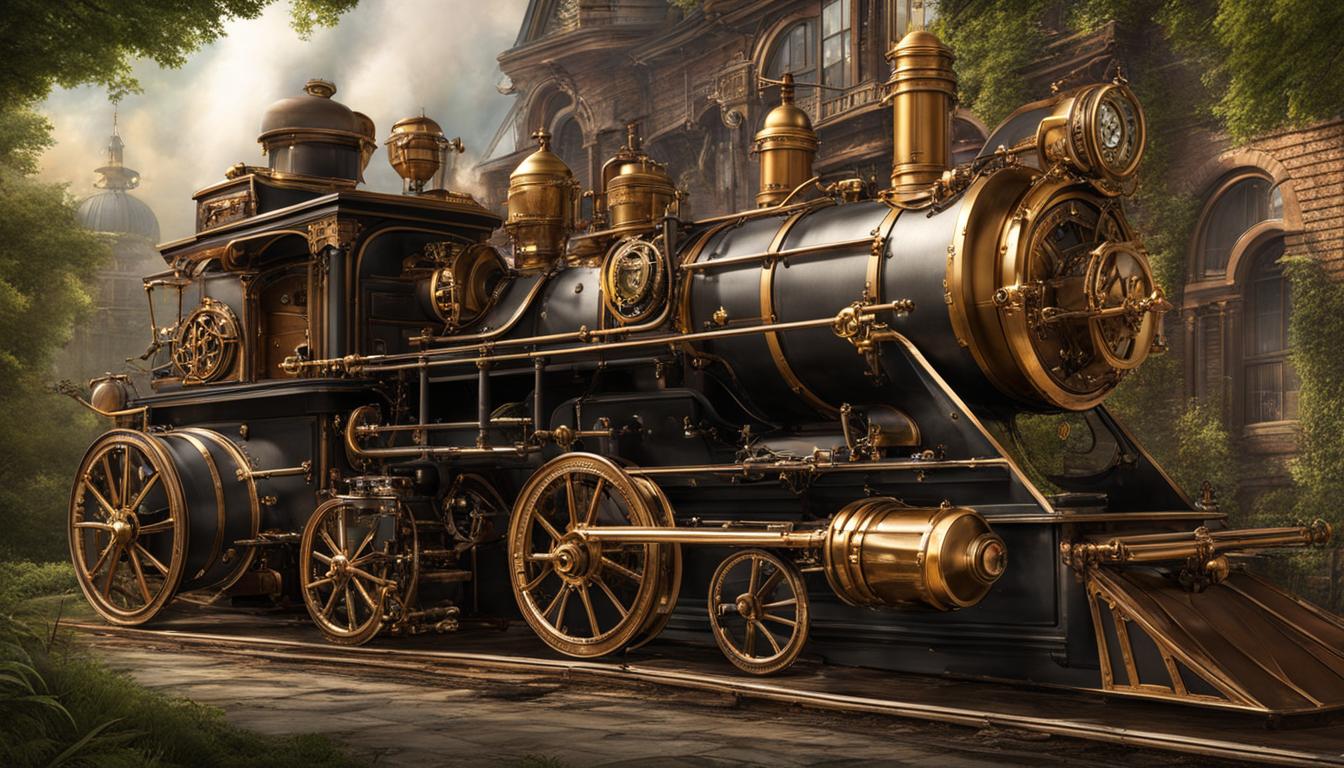Step into a world where history intertwines with fantasy, where the Victorian era meets futuristic technology – welcome to the realm of steampunk. This captivating genre serves as a mirror, reflecting and critiquing the principles and norms of Victorian society. Through its imaginative narratives, steampunk challenges and reshapes Victorian values, offering a fresh perspective on a bygone era.
Steampunk fiction delves into the complexities of Victorian etiquette, exposing the intricacies of societal customs and offering a critical lens on the expectations and traditions of the time. It goes beyond mere nostalgia, providing a deep exploration of the moral fabric that shaped Victorian society. Steampunk’s reflection on Victorian morals and ethics invites readers to question the very foundations upon which the era was built.
In this article, we will take a closer look at how steampunk reimagines Victorian principles, critiques the rigidity of Victorian etiquette, and offers a unique perspective on the societal norms of the era. Prepare to embark on a journey through time and imagination as we unravel the mysteries of steampunk and its reflection on Victorian morals and ethics.
Key Takeaways:
- Steampunk merges history and fantasy, reflecting and critiquing Victorian morals and ethics.
- Through its narratives, steampunk challenges and reshapes Victorian values and societal norms.
- Steampunk delves into the complexities of Victorian etiquette, offering a critical examination of customs and traditions.
- The genre evokes nostalgia for a mechanical past while also expressing regret for Victorian attitudes and values.
- Steampunk utilizes literary techniques to subvert and reshape Victorian principles and etiquette.
The Retrofuturistic Aesthetic of Steampunk
Steampunk, with its unique blend of Victorian era aesthetics and futuristic technology, offers a captivating portrayal of Victorian gender roles, class structures, and moral dilemmas. By combining elements of the past and future, steampunk creates a retrofuturistic world that challenges traditional expectations and explores alternative possibilities.
In the realm of gender roles, steampunk provides a platform for subverting and reimagining Victorian norms. It presents strong, independent female characters who defy societal expectations and take on traditionally masculine roles. Similarly, male characters are not confined to stereotypical portrayals of masculinity, allowing for a more nuanced exploration of gender identity within the Victorian context.
Class structures and inequalities of the Victorian era are also a focal point in steampunk narratives. The genre examines the social hierarchies and injustices of the time, often highlighting the disparities between the upper and lower classes. Through its storytelling, steampunk sheds light on the societal divisions that characterized the Victorian era and encourages reflection on their modern-day implications.
Steampunk’s reflection on Victorian moral dilemmas adds depth to its storytelling, presenting complex ethical debates within the confines of a Victorian setting.
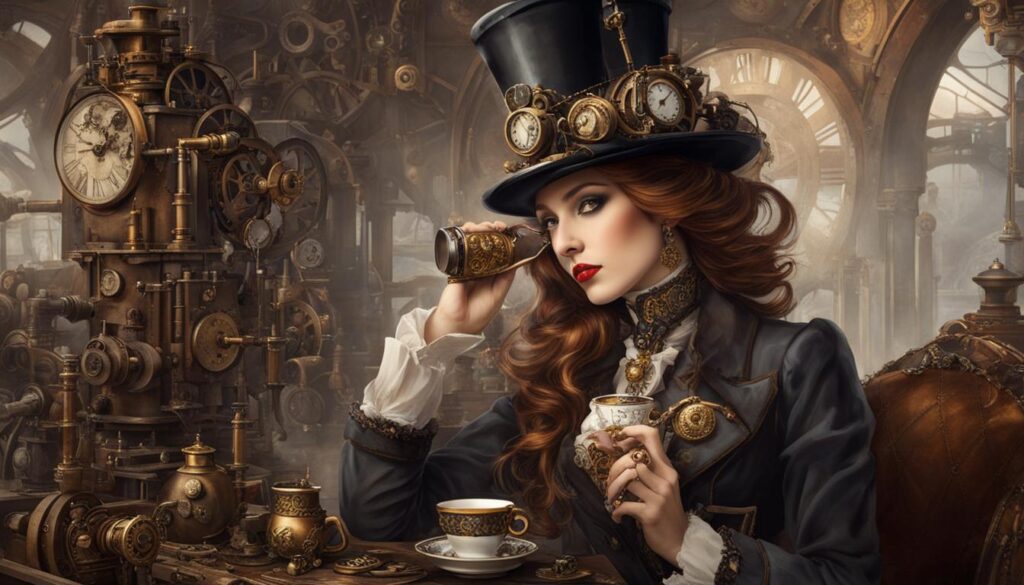
In addition to gender roles and class structures, steampunk delves into the moral dilemmas of the Victorian era. It explores societal taboos and challenges the rigid moral standards of the time. By engaging with these ethical debates, steampunk offers a thought-provoking examination of Victorian values, inviting readers to question and reevaluate their own perspectives.
| Steampunk Element | Victorian Influence |
|---|---|
| Gender Roles | Subversion and reimagining of traditional expectations |
| Class Structures | Exploration of social hierarchies and inequalities |
| Moral Dilemmas | Challenging Victorian societal taboos and standards |
Through its retrofuturistic aesthetic, steampunk offers a fresh perspective on Victorian values and principles. By blending history, fantasy, and technology, the genre continues to captivate readers and inspire critical reflection on the complexities of the Victorian era.
Nostalgia and Regret: The Dual Emotions of Steampunk
Steampunk, with its unique blend of history and imagination, evokes a powerful mix of nostalgia and regret. It transports us to a world that never was, a mechanical marvel inspired by the aesthetics of the Victorian era. This nostalgic longing for a perceived “lost” mechanical world is a central theme in the genre, as steampunk enthusiasts find solace in the intricate gears, brass gadgets, and the romanticism of a bygone era.
However, steampunk is not confined to mere nostalgia. It also expresses a deep sense of regret for the colonial attitudes and patriarchal values that prevailed during the Victorian era. In reimagining this era, steampunk confronts the taboos, restrictions, and inequalities of the time, challenging them through its narratives. By pushing boundaries and exploring societal norms that were often restrictive during the Victorian era, steampunk provides a platform for new interpretations and critical reflections.
Through its nuanced reflection on Victorian taboos, steampunk offers a unique lens through which to view the complexities of the era. It boldly challenges and reimagines Victorian traditions, paving the way for narratives that resonate with contemporary audiences. By acknowledging and grappling with the darker aspects of the past, steampunk provides a space for discussion and exploration, allowing us to examine and learn from the mistakes of history.
Steampunk’s ability to evoke both nostalgia and regret sets it apart as a genre that goes beyond simple imitation or homage. It invites us to question and reflect on the values and traditions of the Victorian era, and to consider how they continue to shape our own society. In doing so, steampunk serves as a powerful reminder that history is not static, but rather a living entity that shapes and is shaped by our present and future.
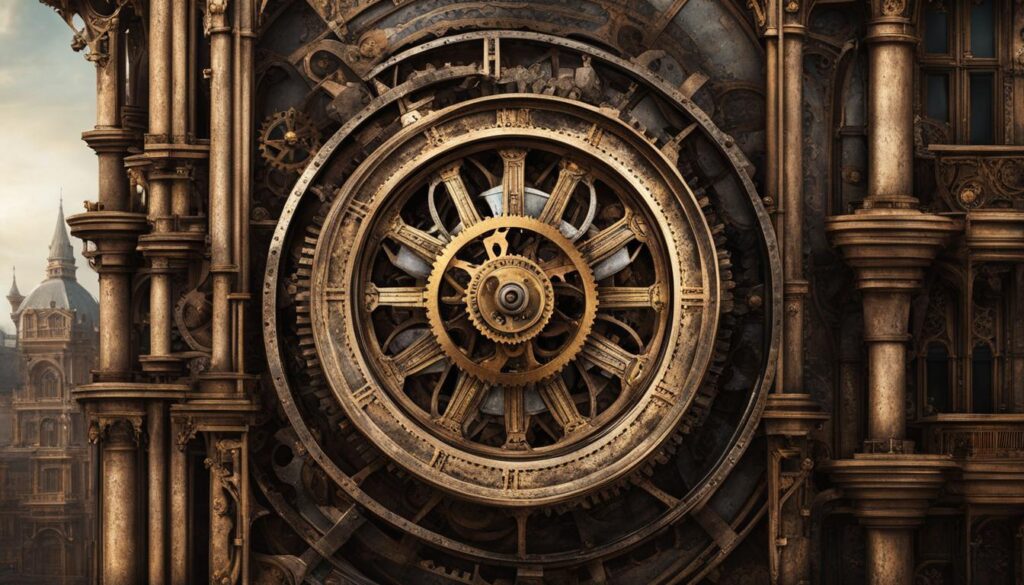
Nostalgia and Regret in Steampunk Art and Fashion
The duality of nostalgia and regret in steampunk is not limited to literature and storytelling – it is also a prominent theme in steampunk art and fashion. Steampunk-inspired artwork often features intricate gears, clockwork mechanisms, and Victorian aesthetics, capturing the essence of a bygone era. These artworks tap into our longing for a world that never was, while also reminding us of the flaws and limitations of the Victorian era. Similarly, steampunk fashion blends Victorian clothing styles with futuristic elements, allowing individuals to express their own nostalgia and critique through their personal style.
Table:
| Steampunk Art | Steampunk Fashion |
|---|---|
| Features intricate gears and clockwork mechanisms | Blends Victorian clothing styles with futuristic elements |
| Evokes nostalgia for a perceived “lost” mechanical world | Allows individuals to express their own nostalgia and critique |
| Reflects on the aesthetics and romanticism of the Victorian era | Challenges traditional gender roles and societal expectations |
Steampunk art and fashion provide a visual representation of the dual emotions of nostalgia and regret. They serve as a creative outlet for individuals to explore and express their own relationship with the past, while also offering a critique of the values and ideals of the Victorian era.
Bricolage and Detournement in Steampunk
Steampunk, as a genre, employs the literary techniques of bricolage and detournement to reshape Victorian values and critique the rigid etiquette of the era. Bricolage is the art of constructing something new from a range of available materials, while detournement involves subverting and repurposing existing elements to create a new meaning or message. In the world of steampunk, these techniques are used to reimagine and challenge the societal norms and expectations of the Victorian era.
Through bricolage, steampunk authors borrow elements from the Victorian and Edwardian past and combine them in innovative ways. The fusion of past and future, magic and science, creates a fresh perspective on the values and traditions of the time. By repurposing and subverting these elements, steampunk challenges the status quo and presents a reflection on Victorian society that is both familiar and unexpected.
Steampunk takes the Victorian era and turns it on its head, offering a critique of the rigid etiquette and social structures of the time. It allows us to explore alternative possibilities and question the values that were upheld during that era.
Through the use of detournement, steampunk authors actively challenge and critique the Victorian etiquette that was prevalent at the time. By subverting the original meaning and purpose of elements such as fashion, technology, and social interactions, steampunk pushes the boundaries of the genre and creates a space for new interpretations and narratives. This subversion of Victorian etiquette allows for a critique of the restrictive nature of societal norms and opens up possibilities for exploring new ideas and perspectives.
In conclusion, bricolage and detournement are key techniques used in steampunk to reshape Victorian values and critique the rigid etiquette of the era. Through borrowing and combining elements from the past, and by subverting and repurposing existing elements, steampunk offers a fresh perspective on societal norms and expectations. By challenging and critiquing Victorian etiquette, steampunk creates a space for exploration and reflection, inviting readers to question and rethink the values and traditions of the Victorian era.
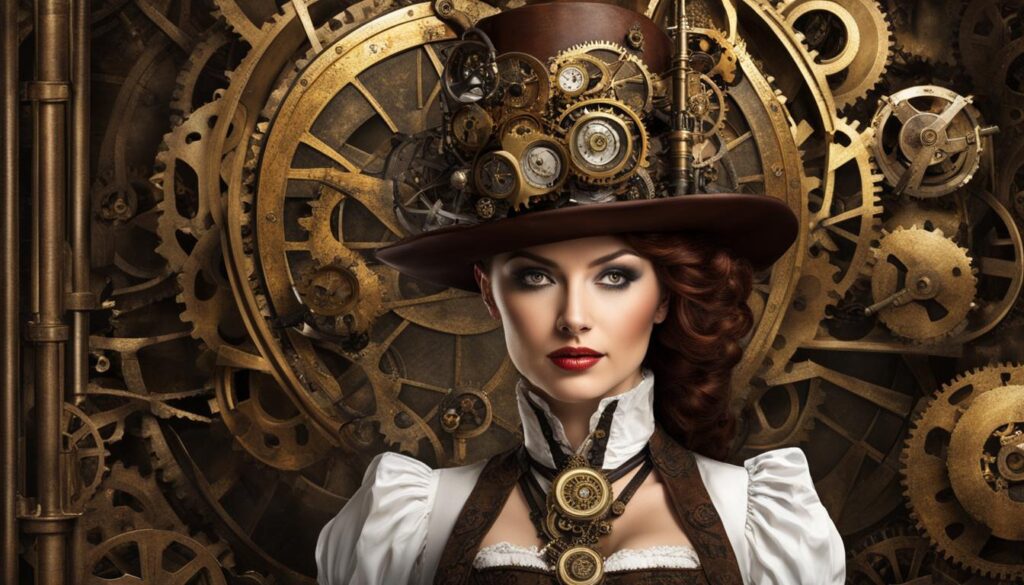
The Steampunk Aesthetic: Neo-Victorianism, Technofantasy, and Retrofuturism
The steampunk genre encompasses a captivating aesthetic that combines elements of neo-Victorianism, technofantasy, and retrofuturism. These three components seamlessly blend together, creating a unique and visually stunning world within the genre.
Neo-Victorianism: Challenging and Subverting Victorian Principles
Steampunk’s neo-Victorianism aspect explores and challenges the principles and values of the Victorian era. It provides a critical examination of the morals and ethics prevalent during that time. Through its narratives, steampunk offers a fresh perspective on Victorian society, questioning societal norms and shedding light on the complexities of the era.
Within the realm of neo-Victorianism, steampunk authors often reimagine and subvert traditional Victorian gender roles, presenting alternative possibilities and breaking away from the confines of traditional expectations. This exploration of gender dynamics allows for thought-provoking storytelling and provides a platform for discussions on gender equality and empowerment.
Technofantasy: Magic and Science in a Unique Blend
Technofantasy is a central component of the steampunk aesthetic, combining elements of magic and science in a seamless blend. Steampunk narratives often feature fantastical elements intertwined with advanced technology, creating a world where the extraordinary becomes possible. This fusion of magic and science adds depth to the genre, offering a sense of wonder and whimsy that captivates readers.
By incorporating technofantasy into their storytelling, steampunk authors explore the boundaries of what is possible, pushing the limits of both historical accuracy and imagination. This blending of genres allows for creative reinterpretations of the Victorian era, offering readers a fresh and engaging experience.
Retrofuturism: Reimagining the Victorian Vision of the Future
Steampunk’s retrofuturism component looks back on the Victorian era’s vision of the future, reimagining and critiquing the technological advancements and social progress that were anticipated during that time. It combines elements of the past and future, creating a unique sense of nostalgia and curiosity.
Retrofuturism in steampunk narratives often takes the form of inventions and technological advancements that mirror or surpass the Victorian era’s expectations. These imaginative reimaginings offer a fresh perspective on what could have been and encourage readers to question the impact of progress and innovation on society.
| Neo-Victorianism | Technofantasy | Retrofuturism |
|---|---|---|
| Challenges Victorian principles | Blends magic and science | Reimagines Victorian vision of future |
| Examines societal norms | Offers a sense of wonder | Critiques technological advancements |
| Subverts gender roles | Pushes the boundaries of imagination | Encourages reflection on progress |
The Complexities of Steampunk Expression
Steampunk is a genre that defies easy categorization, encompassing a wide range of expressions and interpretations. It reflects on Victorian societal norms, challenging and reimagining traditions that were prevalent during the era. Steampunk offers a platform for exploration and critique in a way that goes beyond simple nostalgia or imitation. It allows for the examination of the complexities of Victorian society, shedding light on both the progress and regressions of the time.
The genre of steampunk embraces the complexities of Victorian society, providing a space for both celebration and critique. By reflecting on Victorian societal norms, steampunk encourages a deeper exploration of the values and beliefs that shaped the era. It challenges traditional concepts of gender roles, offering narratives that feature strong, independent female characters who defy societal expectations. At the same time, it also delves into the class structures and inequalities of the Victorian era, highlighting the disparity between the upper and lower classes.
Victorian traditions are often challenged and reimagined in the world of steampunk. From alternative histories that rewrite the course of events to subversions of Victorian taboos, steampunk allows for a reevaluation of the past. It presents a unique opportunity to examine the complexities of Victorian society, shedding light on both its accomplishments and shortcomings. By doing so, steampunk becomes more than just a nostalgic homage to the past; it becomes a thought-provoking exploration of the human experience.
Victorian Traditions Challenged by Steampunk
The genre of steampunk challenges Victorian traditions in a variety of ways. One such way is through the reimagining of gender roles, providing female characters with agency and independence that were often denied to them during the Victorian era. Steampunk also challenges traditional notions of class and social hierarchies, exploring the consequences of inequality and the pursuit of power. Through these challenges, steampunk offers a critical reflection on Victorian societal norms and values.
Reflection on Victorian Societal Norms in Steampunk
Steampunk serves as a unique medium for reflection on Victorian societal norms. It allows for a reexamination of the values and beliefs that shaped the era, offering a platform to critically engage with the complexities of Victorian society. By challenging and reimagining traditions, steampunk sheds light on both the progress and regressions of the time, provoking thoughtful analysis and discussion.
Steampunk’s Impact on Literature and Culture
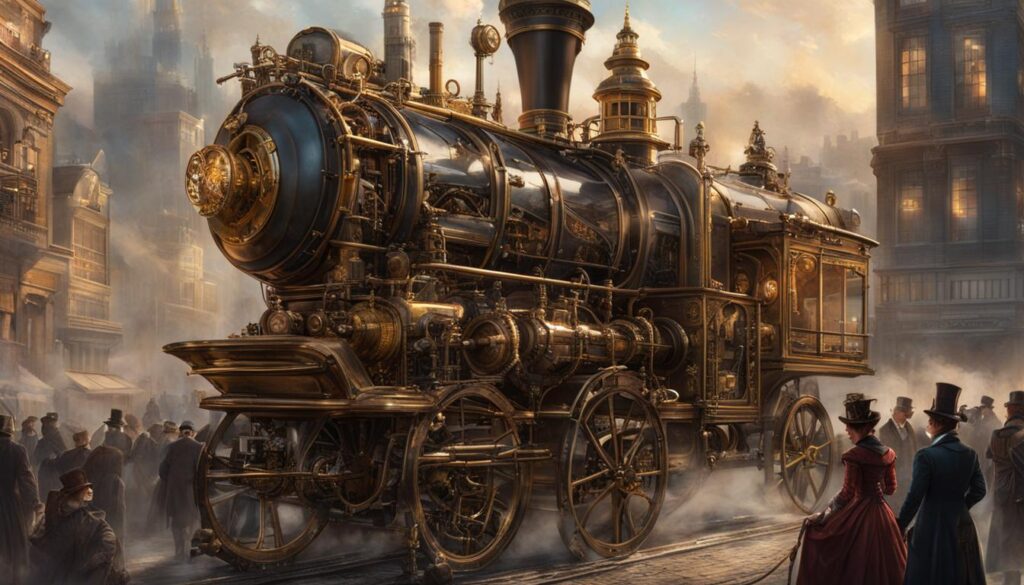
Steampunk’s reflection on Victorian morals and ethics has permeated the world of literature and left an indelible mark on popular culture. Through its Victorian settings, steampunk opens avenues for engaging ethical debates that resonate with contemporary audiences. By exploring complex moral dilemmas within the confines of a Victorian backdrop, steampunk authors challenge societal norms and provoke thought-provoking discussions.
One of the key aspects that steampunk narratives often delve into is the class structures of the Victorian era. By examining the disparities and injustices prevalent at the time, steampunk provides a critical lens through which readers can confront the social hierarchies of the past. This exploration of class dynamics not only adds depth to the stories but also offers a broader understanding of the complexities of Victorian society.
In addition to its ethical and social commentary, steampunk literature captivates readers through its imaginative world-building and retrofuturistic aesthetics. The genre’s fusion of Victorian principles with futuristic technology creates a unique blend of past and future, appealing to those with a penchant for both history and fantasy. Steampunk’s ability to transport readers to a different time and place has solidified its position as a beloved genre within literature and has influenced various forms of media, including film, fashion, and art.
Ethical Debates in Steampunk’s Victorian Settings
Steampunk narratives often serve as a stage for engaging ethical debates within the context of Victorian settings. By exploring complex moral dilemmas that resonate with contemporary audiences, these stories encourage readers to consider the implications of certain actions and decisions. From discussions on the impact of technological advancements on society to examinations of colonial attitudes and patriarchal values, steampunk provokes thoughtful analysis of the past, present, and future.
Victorian Class Structures in Steampunk Tales
The exploration of Victorian class structures is a recurring theme in steampunk literature. By shining a light on the disparities and injustices prevalent in the Victorian era, steampunk authors highlight the social hierarchies of the past and the consequences they had on individuals and society as a whole. Through these narratives, readers gain a deeper understanding of the complexities of Victorian society and can reflect on how class dynamics continue to shape our world.
Conclusion
Steampunk, with its blend of history and imagination, serves as a powerful reflection on Victorian morals and ethics. It offers a fresh perspective on the era by critiquing and reshaping Victorian principles, exploring gender roles and societal norms, and challenging traditional values. Through its aesthetic, storytelling, and cultural impact, steampunk continues to captivate both literature enthusiasts and casual readers alike, offering profound insights into the complexities of Victorian morals and ethics.
By delving into the intricacies of Victorian etiquette and class structures, steampunk narratives shed light on the disparities and injustices of the time. The genre’s reflection on Victorian societal norms goes beyond mere nostalgia or imitation, allowing for a deeper examination of both the progress and regressions of the era. Steampunk offers a platform for exploration and critique, sparking ethical debates within the framework of its Victorian settings and encouraging readers to critically engage with the values of the past.
Steampunk’s impact on literature and popular culture cannot be understated. With its thought-provoking storytelling, the genre challenges societal norms and extends the boundaries of imagination. Through its exploration of moral dilemmas and its reinterpretation of Victorian traditions, steampunk continues to shape the literary landscape. By reflecting on Victorian morals and ethics, steampunk remains a genre that both entertains and enlightens, providing a unique lens through which to view the complexities of the past.
FAQ
What is steampunk?
Steampunk is a genre that combines elements of the Victorian era with futuristic technology, offering a unique blend of history and imagination.
How does steampunk reflect Victorian morals and ethics?
Steampunk explores and critiques Victorian principles through its narratives, challenging and reshaping societal norms of the era.
What aspects of Victorian society does steampunk examine?
Steampunk delves into the complexities of Victorian etiquette, gender roles, class structures, and moral dilemmas.
What is the steampunk aesthetic?
The steampunk aesthetic combines neo-Victorianism, technofantasy, and retrofuturism to create a unique blend of magic, science, and nostalgia.
How does steampunk critique Victorian traditions?
Steampunk challenges and reimagines Victorian values, pushing the boundaries of the genre and allowing for exploration of previously taboo topics.
How does steampunk reshape Victorian values?
Steampunk utilizes the literary techniques of bricolage and detournement to subvert and invert the original meaning of Victorian elements, creating something entirely new.
What impact does steampunk have on literature and popular culture?
Steampunk sparks ethical debates within its Victorian settings, examines class structures, and offers a platform for exploration and critique of societal norms.
How does steampunk engage with contemporary audiences?
Steampunk’s thought-provoking storytelling and reflection on Victorian values encourage readers to critically engage with the complexities of Victorian morals and ethics.
Source Links
- http://steampunkscholar.blogspot.com/2012/06/frank-reade-adventures-in-age-of.html?m=1
- https://scholar.archive.org/work/qszafq4sd5hkthqrgj6fedzzoy/access/wayback/https://era.library.ualberta.ca/items/af46dcb5-93c2-4562-8328-fc8b06c35d36/view/62128291-a452-4153-940b-51be53df9442/Perschon_Mike_2012.pdf

